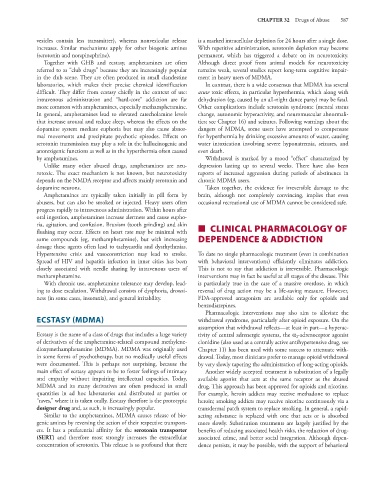Page 601 - Basic _ Clinical Pharmacology ( PDFDrive )
P. 601
CHAPTER 32 Drugs of Abuse 587
vesicles contain less transmitter), whereas nonvesicular release is a marked intracellular depletion for 24 hours after a single dose.
increases. Similar mechanisms apply for other biogenic amines With repetitive administration, serotonin depletion may become
(serotonin and norepinephrine). permanent, which has triggered a debate on its neurotoxicity.
Together with GHB and ecstasy, amphetamines are often Although direct proof from animal models for neurotoxicity
referred to as “club drugs” because they are increasingly popular remains weak, several studies report long-term cognitive impair-
in the club scene. They are often produced in small clandestine ment in heavy users of MDMA.
laboratories, which makes their precise chemical identification In contrast, there is a wide consensus that MDMA has several
difficult. They differ from ecstasy chiefly in the context of use: acute toxic effects, in particular hyperthermia, which along with
intravenous administration and “hard-core” addiction are far dehydration (eg, caused by an all-night dance party) may be fatal.
more common with amphetamines, especially methamphetamine. Other complications include serotonin syndrome (mental status
In general, amphetamines lead to elevated catecholamine levels change, autonomic hyperactivity, and neuromuscular abnormali-
that increase arousal and reduce sleep, whereas the effects on the ties; see Chapter 16) and seizures. Following warnings about the
dopamine system mediate euphoria but may also cause abnor- dangers of MDMA, some users have attempted to compensate
mal movements and precipitate psychotic episodes. Effects on for hyperthermia by drinking excessive amounts of water, causing
serotonin transmission may play a role in the hallucinogenic and water intoxication involving severe hyponatremia, seizures, and
anorexigenic functions as well as in the hyperthermia often caused even death.
by amphetamines. Withdrawal is marked by a mood “offset” characterized by
Unlike many other abused drugs, amphetamines are neu- depression lasting up to several weeks. There have also been
rotoxic. The exact mechanism is not known, but neurotoxicity reports of increased aggression during periods of abstinence in
depends on the NMDA receptor and affects mainly serotonin and chronic MDMA users.
dopamine neurons. Taken together, the evidence for irreversible damage to the
Amphetamines are typically taken initially in pill form by brain, although not completely convincing, implies that even
abusers, but can also be smoked or injected. Heavy users often occasional recreational use of MDMA cannot be considered safe.
progress rapidly to intravenous administration. Within hours after
oral ingestion, amphetamines increase alertness and cause eupho-
ria, agitation, and confusion. Bruxism (tooth grinding) and skin
flushing may occur. Effects on heart rate may be minimal with ■ CLINICAL PHARMACOLOGY OF
some compounds (eg, methamphetamine), but with increasing DEPENDENCE & ADDICTION
dosage these agents often lead to tachycardia and dysrhythmias.
Hypertensive crisis and vasoconstriction may lead to stroke. To date no single pharmacologic treatment (even in combination
Spread of HIV and hepatitis infection in inner cities has been with behavioral interventions) efficiently eliminates addiction.
closely associated with needle sharing by intravenous users of This is not to say that addiction is irreversible. Pharmacologic
methamphetamine. interventions may in fact be useful at all stages of the disease. This
With chronic use, amphetamine tolerance may develop, lead- is particularly true in the case of a massive overdose, in which
ing to dose escalation. Withdrawal consists of dysphoria, drowsi- reversal of drug action may be a life-saving measure. However,
ness (in some cases, insomnia), and general irritability. FDA-approved antagonists are available only for opioids and
benzodiazepines.
Pharmacologic interventions may also aim to alleviate the
ECSTASY (MDMA) withdrawal syndrome, particularly after opioid exposure. On the
assumption that withdrawal reflects—at least in part—a hyperac-
Ecstasy is the name of a class of drugs that includes a large variety tivity of central adrenergic systems, the α -adrenoceptor agonist
2
of derivatives of the amphetamine-related compound methylene- clonidine (also used as a centrally active antihypertensive drug, see
dioxymethamphetamine (MDMA). MDMA was originally used Chapter 11) has been used with some success to attenuate with-
in some forms of psychotherapy, but no medically useful effects drawal. Today, most clinicians prefer to manage opioid withdrawal
were documented. This is perhaps not surprising, because the by very slowly tapering the administration of long-acting opioids.
main effect of ecstasy appears to be to foster feelings of intimacy Another widely accepted treatment is substitution of a legally
and empathy without impairing intellectual capacities. Today, available agonist that acts at the same receptor as the abused
MDMA and its many derivatives are often produced in small drug. This approach has been approved for opioids and nicotine.
quantities in ad hoc laboratories and distributed at parties or For example, heroin addicts may receive methadone to replace
“raves,” where it is taken orally. Ecstasy therefore is the prototypic heroin; smoking addicts may receive nicotine continuously via a
designer drug and, as such, is increasingly popular. transdermal patch system to replace smoking. In general, a rapid-
Similar to the amphetamines, MDMA causes release of bio- acting substance is replaced with one that acts or is absorbed
genic amines by reversing the action of their respective transport- more slowly. Substitution treatments are largely justified by the
ers. It has a preferential affinity for the serotonin transporter benefits of reducing associated health risks, the reduction of drug-
(SERT) and therefore most strongly increases the extracellular associated crime, and better social integration. Although depen-
concentration of serotonin. This release is so profound that there dence persists, it may be possible, with the support of behavioral

